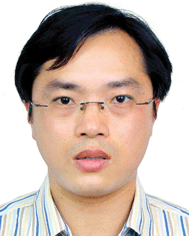Supramolecular polymers†
Feihe
Huang
a and
Oren A.
Scherman
b
aMOE Key Laboratory of Macromolecular Synthesis and Functionalization, Department of Chemistry, Zhejiang University, Hangzhou 310027, P. R. China. E-mail: fhuang@zju.edu.cn; Fax: +86-571-8795-3189; Tel: +86-571-8795-3189
bMelville Laboratory for Polymer Synthesis, Department of Chemistry, Cambridge University, Lensfield Road, Cambridge CB2 1EW, UK. E-mail: oas23@cam.ac.uk
 Feihe Huang | Feihe Huang was born in China in 1973. He obtained his degree of Doctor of Philosophy in Chemistry from Virginia Polytechnic Institute and State University (VT) under the guidance of Prof. Harry W. Gibson in March 2005. Then he joined Prof. Peter J. Stang's group at University of Utah as a postdoctoral researcher. He became a Professor of Chemistry at Zhejiang University in December 2005. His current research interests are supramolecular polymers and pillararene supramolecular chemistry. The awards he received up to now include the 2004 Chinese Government Award for Outstanding Self-Financed Students Abroad, the Outstanding PhD Dissertation Award from VT, the Thieme Chemistry Journals Award and Humboldt Fellowship for Experienced Researchers. |
 Oren A. Scherman | Oren Scherman graduated from Cornell University in Ithaca, New York with a BA in Chemistry in 1999. He then went on to complete a PhD under the supervision of Professor Robert H. Grubbs at the California Institute of Technology (Caltech) in Pasadena, California in 2004. After finishing his PhD in the area of olefin metathesis and controlled polymerisation, he moved to the Netherlands to work on supramolecular polymers, at the Eindhoven University of Technology (TU/e), with Professors E. W. (Bert) Meijer and Rint P. Sijbesma. In 2006, he moved to Cambridge to take an academic position where he is now a University Reader in Supramolecular and Polymer Chemistry and Next Generation Fellow in the Melville Laboratory for Polymer Synthesis in the Department of Chemistry at the University of Cambridge. Oren and his research group are interested in studying supramolecular polymers, hydrogels and composite materials and their dynamics of assembly in an aqueous environment. |
The field of supramolecular chemistry has advanced to a level on which it is possible to select building blocks that will self-assemble into exciting structures ranging from simple host–guest systems based on molecular recognition to highly complex functional supramolecular materials. As a highly active and significant part of supramolecular chemistry, supramolecular polymers, which can be defined as polymeric systems that extend beyond the molecule and utilize noncovalent interactions to direct their assembly, to control their conformations, and/or to define their behavior, have captured more and more attention from the scientific community. The use of reversible and strong unidirectional noncovalent interactions among supramolecular monomers can not only achieve some of the important properties of conventional polymers (for example viscosity), but also realize some fascinating functionalities that are not known in conventional polymers, such as processability, recycling, and self-healing. The responsiveness to external stimuli may further provide a range of potential applications in areas ranging from smart/adaptive materials to energy and medicine and to environmental sustainability. Definitely, it is an area of great interest and challenge. Therefore, it is timely and important to publish a themed issue on the topic of supramolecular polymers in Chemical Society Reviews.
The main goals of this themed issue on supramolecular polymers by some of the leading researchers on the subject are to highlight the advances, to celebrate the achievements, to survey the potential and to exploit the further applications in materials science.
Supramolecular polymers can be prepared by employing various noncovalent polymerization methods. However, standard techniques for the characterization of supramolecular polymers have yet to be established. The dynamic nature of supramolecular polymers makes them difficult to be fully characterized using conventional polymer techniques. Therefore, Zhang and co-workers (DOI: 10.1039/c2cs35084j) summarize various methods for characterizing supramolecular polymers.
Being responsive and adaptive to external stimuli is an intrinsic merit of most natural species. Inspired by this, scientists have been applying themselves to design and develop structurally defined materials with externally addressable properties at the molecular level. Huang and co-workers (DOI: 10.1039/c2cs35091b) provide insights into the design, functionalization, and applications of stimuli-responsive supramolecular polymeric materials; while Liu, Zhang and co-workers (DOI: 10.1039/c2cs35103j) present recent developments focusing on enzyme-responsive polymeric assemblies, nanoparticles, and hydrogels.
Supramolecular polymers are brought together by reversible and highly directional secondary interactions. Therefore, a variety of noncovalent interactions, such as multiple hydrogen bonding, hydrophobic interactions, π–π stacking, metal–ligand coordination, host–guest recognition, and integrated noncovalent interactions, can be used to bring the building blocks together to prepare supramolecular polymers. Liu and Guo (DOI: 10.1039/c2cs35075k) summarize in detail the current stage of fabrication of calixarene-based supramolecular polymers driven by host–guest recognition. Wang and co-workers (DOI: 10.1039/c2cs35099h) survey the reported supramolecular polymers fully or partially created from the combination of multiple noncovalent building interactions, mainly of two types, in an orthogonal manner. Loeb and Vukotic (DOI: 10.1039/c2cs35141b) review exclusively a class of supramolecular coordination polymers in which the linking ligands are mechanically interlocked rotaxane molecules, namely, rotaxane coordination polymers (RCP). Stoddart and co-workers (DOI: 10.1039/c2cs35167f) focus on the development of Dynamic Covalent Chemistry (DCC) to produce synthetic mechanically interlocked polymers with precise and concise primary structures. Palmans and co-workers (DOI: 10.1039/c2cs35156k) highlight recent advances in the development of different types of benzene-1,3,5-tricarboxamides (BTAs) and their applications for supramolecular chemistry. Jiang and co-workers (DOI: 10.1039/c2cs35157a) describe the basic design concepts, the recent synthetic advancements and structural studies, and the frontiers of functional exploration of Covalent Organic Frameworks (COFs).
Layer-by-layer (LbL) assembly has been proven to be a convenient and versatile method to fabricate functional supramolecular polymeric materials. Sun and co-workers (DOI: 10.1039/c2cs35107b) review the methods for rapid fabrication of thick polymeric films involving LbL assembly and discuss the functions of such thick films. Gao and co-workers (DOI: 10.1039/c2cs35088b) give an overview of very recent advances on the use of microcapsules prepared by the LbL technique as multifunctional drug carriers, biosensors, and bioreactors.
Supramolecular polymeric superstructured materials have widespread applications in many fields. Yang and co-workers (DOI: 10.1039/c2cs35038f) summarize the development of new methods for fabricating regular self-assembly architectures, highlight the reversible assembly and disassembly behavior, and indicate the potential applications on the basis of the recent progress in fabricating inorganic nanoparticle–polymer composites. Zhou and co-workers (DOI: 10.1039/c2cs35130g) summarize the self-assembly of biocompatible or biodegradable amphiphilic hyperbranched polymers (HBPs) and their cytomimetic and biomedical applications; while Twyman and co-workers (DOI: 10.1039/c2cs35238a) review the use of hyperbranched polymers as synthetic enzyme mimics and show how the principles of encapsulation and supramolecular chemistry are exploited in biomimetic catalysis. Eisenberg and Mai (DOI: 10.1039/c2cs35115c) introduce the primary principles of block copolymer (BCP) self-assembly in bulk and in solution, by describing experiments, theories, accessible morphologies and morphological transitions, factors affecting the morphology, thermodynamics and kinetics, etc. Feng and co-workers (DOI: 10.1039/c2cs35179j) provide an outlook on the state-of-the-art strategies that have been established to construct chemically modified graphene (CMG) based functional materials of different dimensionalities and highlight the applications of the resultant CMG based materials.
Biomacromolecules are the building blocks of life and nature has evolved countless biomacromolecules that show promise for self-assembled supramolecular polymeric materials. Niu and co-workers (DOI: 10.1039/c2cs35108k) review recent developments in the use of virus coat proteins (VCPs) and virus nanoparticles (VNPs) as building blocks for self-assembly investigation and materials exploitation. Perrier, Jolliffe and co-workers (DOI: 10.1039/c2cs35172b) present a comprehensive overview of functional nanotubes from the self-assembly of cyclic peptides with alternating D- and L-residues and highlight their applications.
Supramolecular gels formed from the assembly of low molecular weight gelators are a highly tailorable class of materials that have found use in applications ranging from biomaterials to sensors. Moreover, multi-component supramolecular gels, in which more than one compound is added to the solvent, offer a facile way to tailor the properties of the gel. Therefore, Rowan and Buerkle (DOI: 10.1039/c2cs35106d) review recent developments in multi-component supramolecular gels. On the other hand, Scherman and co-workers (DOI: 10.1039/c2cs35264h) summarize the studies on supramolecular polymeric hydrogels by supramolecular crosslinking of traditional polymer chains in water by specific, directional and dynamic non-covalent interactions.
Finally, we are very grateful to all involved authors for their contributions to the writing of these wonderful reviews which are contained in this themed issue of Chemical Society Reviews. Of equal importance, supramolecular polymer chemistry is a highly promising area. Organizing this themed issue was a beneficial experience for us, and we hope that you will enjoy these representative reviews and find them useful in your research and teaching.
Footnote |
| † Part of a themed issue on supramolecular polymers. |
| This journal is © The Royal Society of Chemistry 2012 |
